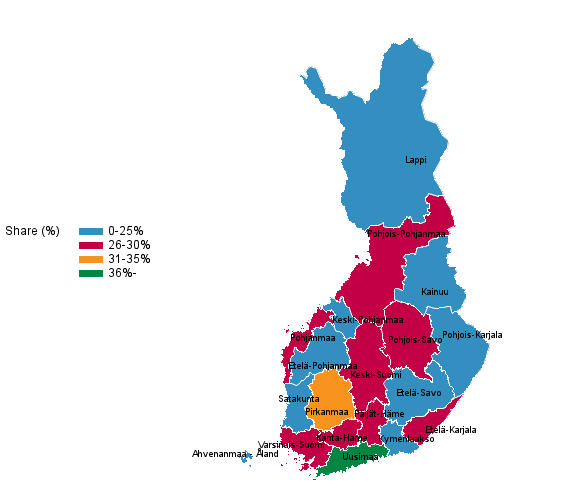Published: 2 November 2017
Level of education highest in Uusimaa in 2016
Corrected on 7 November 2017. The two corrections are indicated in red.
By the end of 2016, altogether 3,287,272 persons, or 71 per cent of the population aged 15 or over had completed a post-comprehensive level qualification. The share of persons with qualifications remained unchanged from the previous year. The population with the highest education lived in Uusimaa, where 37 per cent of the population had completed a tertiary level qualification.
Population with tertiary level qualifications by region in 2016, per cent (Correctec on 7 November 2017)

In addition to Uusimaa, the population with the highest education in 2016 lived in Pirkanmaa, where 31 per cent of the population had completed a tertiary level qualification and in Varsinais-Suomi, where the share of those with a tertiary level qualification in the population was 30 per cent. In Mainland Finland the share of those with tertiary level qualifications was lowest in Kainuu, where 24 per cent of the population had completed a qualification., 23 per cent of the population had completed a tertiary level qualification in ┼land. Women were more highly educated than men in all regions. More detailed information about the regional distribution of educational level can be found in the database tables .
In 2016, there were 115,071 persons aged 20 to 29 with only basic level education, making up 17 per cent of the age group. Among men, 19 per cent of the age group had only basic level education and 15 per cent among women. The share of those with only basic level education was at its lowest at the beginning of the 2000s when it was 16 per cent. The number of persons aged 20 to 29 with only basic level education was highest in Uusimaa, where 21 per cent of the age group had no post-comprehensive level qualification. The share of persons with only basic level education was lowest in South Ostrobothnia, where 12 per cent of those aged 20 to 29 had no post-comprehensive level qualification.
Educational attainment of second level immigrants with foreign background by age 2016
| Age | Total | Basic education or less | Population with educational qualifications | Upper secondary /Post-secondary non tertiary education | Tertiary education | |||||
| % | % | % | % | % | ||||||
| Total | 13 135 | 100,0 | 7 808 | 59,4 | 5 327 | 40,6 | 4 264 | 32,5 | 1 063 | 8,1 |
| 15-19 | 6 198 | 100,0 | 5 685 | 91,7 | 513 | 8,3 | 513 | 8,3 | . | . |
| 20-24 | 3 787 | 100,0 | 1 141 | 30,1 | 2 646 | 69,9 | 2 549 | 67,3 | 97 | 2,6 |
| 25-34 | 782 | 100,0 | 201 | 25,7 | 581 | 74,3 | 381 | 48,7 | 200 | 25,6 |
| 35-44 | 161 | 100,0 | 33 | 20,5 | 128 | 79,5 | 58 | 36,0 | 70 | 43,5 |
| 45-54 | 160 | 100,0 | 20 | 12,5 | 140 | 87,5 | 77 | 48,1 | 63 | 39,4 |
| 55-64 | 493 | 100,0 | 107 | 21,7 | 386 | 78,3 | 218 | 44,2 | 168 | 34,1 |
| 65-74 | 1 063 | 100,0 | 370 | 34,8 | 693 | 65,2 | 359 | 33,8 | 334 | 31,4 |
| 75- | 491 | 100,0 | 251 | 51,1 | 240 | 48,9 | 109 | 22,2 | 131 | 26,7 |
Second generation immigrants with foreign background, i.e. those born in Finland, are mainly young people. In all, 76 per cent of second generation immigrants with foreign background belonged to the age group 15 to 24, whose studies were only beginning. Altogether 70 per cent of second generation immigrants with foreign background aged 20 to 24 had completed a qualification, which is 13 percentage points lower than the share of those with qualifications among the population in the same age group. Among second generation immigrants with foreign background, those aged 35 to 45 had the highest education, as 44 per cent of them had completed a tertiary level qualification.
Starting from the statistical reference year 2016, Statistics Finland reports education data using the new Finnish Standard Classification of Education, which corresponds to the International Standard Classification of Education ISCED 2011. The database tables of the statistics on the educational structure of the population have been changed in line with the new Standard Classification of Education.
Source: Education 2016. Statistics Finland
Inquiries: Mika Witting 029 551 3530, koulutustilastot@stat.fi
Director in charge: Jari Tarkoma
Publication in pdf-format (239.3 kB)
- Tables
-
Tables in databases
Pick the data you need into tables, view the data as graphs, or download the data for your use.
Appendix tables
Updated 2.11.2017
Official Statistics of Finland (OSF):
Educational structure of population [e-publication].
ISSN=2242-2919. 2016. Helsinki: Statistics Finland [referred: 19.4.2025].
Access method: http://stat.fi/til/vkour/2016/vkour_2016_2017-11-02_tie_001_en.html

